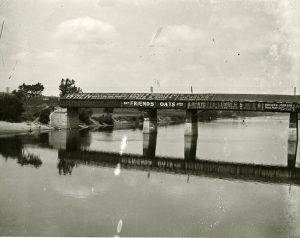“Lafayette’s First Bridge Over the Wabash”
By George E. Gould
[This article first appeared in the TCHA membership newsletter “Weatenotes”, Nol. 18, No. 3, March 1985]
As early as the 1830’s the merchants of Lafayette realized that a bridge across the Wabash River was necessary for the growth of the town. Thus in 1837, 1841, 1843 and 1845, private companies were organized to build a bridge and were each given a charter by the State with permission to construct a bridge. Finally the 1845 company, formed by five prominent businessmen, came up with sufficient money–about $20,000 –- to build the bridge. These men were John Purdue, Nathan H. Stockwell, John L. Reynolds, Robert Heath, and David Ross. The Lafayette Bridge Company completed the Brown Street Bridge in 1847.
The right to build bridges over navigable streams was retained by the State up to 1855. In order to build such a structure, it was necessary to sell stock to raise money, and then make application to the State for a charter. The earlier failures to build a bridge were due to the inability of the organizers to raise the money and complete the work within the three-year limit set by the Legislature.

The 1847 Brown Street Bridge built by the Lafayette Bridge Company was a covered, wooden structure of some 700 feet. The 1868 bird’s eye view of the town shows an eight-span structure: the west span was 150 feet long; the second span was short and said by some to be a turn-span to permit boats to go upstream; spans three, four and five were about 150 feet long and rested on piers in the river; span six ran from the last pier in the river to one on the east bank; span seven was over the west bank; and span eight was over the Wabash & Erie Canal. An 1894 lithograph of the town by Pauli [a reprint of which is available for sale in the Museum gift shop] shows only four, or perhaps five, spans. Since the canal had been closed by that date, it is possible that the two east spans had been removed.
The year of the bridge completion is usually accepted as 1847, although various authors quote 1845 and 1849. Since the bridge was privately owned, the County Commissioners had nothing to do with it operation. The first mention of it was found in the Commissioners’ Records of 1849 when tolls were paid for the passage of certain officials and inmates of the “Poor Asylum”. The builder of the bridge is not known, although R.P. DeHart in his book Past and Present History of Tippecanoe County credits Hiram L. Kilburn as the builder and the year as 1847. However, research shows that Kilburn was born in 1833 and thus would have been 14 years old at the time. The first record of Kilburn in the county appears to be a marriage license issued to him in 1858 to marry Elizabeth Parker.
The success of the Brown Street Bridge induced another group of business people to form the Main Street Bridge Company and to build a covered bridge in 1863. This structure was probably built by Kilburn, as at the time he was frequently hired by the County to repair and build small bridges. The competition between the two bridge companies became so intense that both were on the verge of bankruptcy. Thus on January 1, 1867 officials of the two companies signed an eight-page agreement setting down rules and tolls to be charged. In addition, it provided for a sharing of the income whereby the company with the larger income would give two-fifths of the difference to the other company. The original agreement and the 12 monthly receipts for 1867 are located in the historical association Archives. These are the only records known to exist of these two companies.
In 1871 the County agreed to buy the two bridges for $50,000. However, certain disgruntled taxpayers took the matter to the courts, and it was 1875 before the County obtained titles to the structures and immediately made them toll-free. After a few years certain structural flaws developed in the Main Street Bridge, and so in 1889 Wallace Marshall was given a contract to replace the wooden structure with a three-span iron bridge.
The Brown Street Bridge continued in use but mostly for bringing farm produce and livestock into Lafayette. A story tells of an ingenious woman who drove nails partially into the inside bridge timbers. As loads of hay passed through, some was torn off. Daily this woman would gather the loose hay and take it home to feed her cow. But this accumulation of loose hay on the floor and the overhead bracing made the structure vulnerable to fire. And this is what happened on October 6, 1901, when an arsonist spread oil in the bridge and set it afire.






